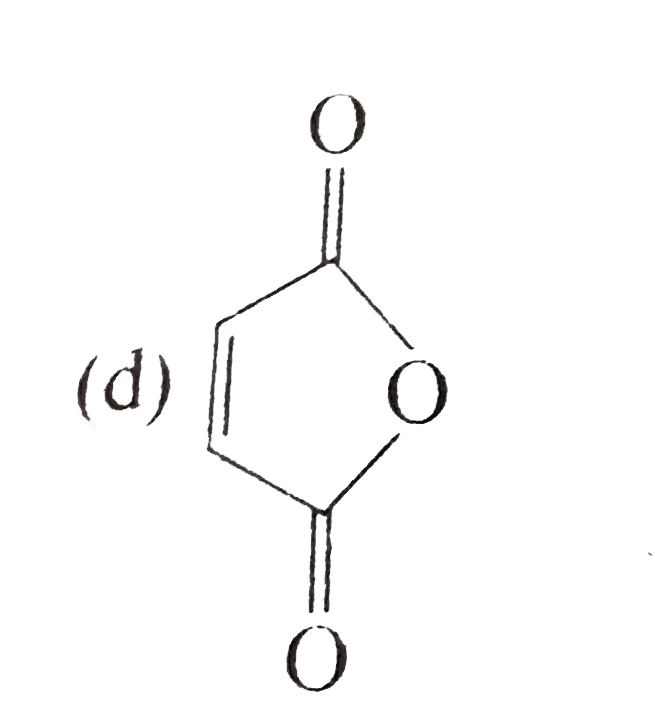(ii) Why is the boiling point of acid anhydride higher than the acid from which it is obtained ?
To understand why the boiling point of acid anhydrides is higher than that of the corresponding acids from which they are derived, we can break down the explanation into several key points:
1. Definition of Acid Anhydrides:
- Acid anhydrides are derived from acids by the removal of water. For example, acetic acid (CH3COOH) can be converted into acetic anhydride ((CH3CO)2O) by the removal of water.
2. Molecular Structure:
- Acid anhydrides generally have a more complex molecular structure compared to their corresponding acids. For instance, acetic anhydride has two carbonyl (C=O) groups, while acetic acid has only one.
3. Intermolecular Forces:
- The boiling point of a substance is largely determined by the strength of intermolecular forces. Acid anhydrides have stronger intermolecular forces compared to acids. This is due to the presence of multiple carbonyl groups that can engage in dipole-dipole interactions and possibly hydrogen bonding (though less than in acids).
4. Molecular Weight:
- Acid anhydrides typically have a higher molecular weight than the corresponding acids. Higher molecular weight often correlates with higher boiling points because larger molecules tend to have greater London dispersion forces.
5. Crystal Lattice Structure:
- In solid form, acid anhydrides can form a more tightly packed crystal lattice structure compared to acids. This tight packing contributes to stronger interactions between molecules, requiring more energy (higher temperature) to break these interactions during the phase change from liquid to gas.
6. Conclusion:
- Therefore, due to their larger molecular size, stronger intermolecular forces, and tightly packed crystal lattice, acid anhydrides exhibit higher boiling points than the corresponding acids.
Summary:
The boiling point of acid anhydrides is higher than that of the corresponding acids due to their larger molecular structure, stronger intermolecular forces, and tightly packed crystal lattice.
- Acid anhydrides are derived from acids by the removal of water. For example, acetic acid (CH3COOH) can be converted into acetic anhydride ((CH3CO)2O) by the removal of water.
- Acid anhydrides generally have a more complex molecular structure compared to their corresponding acids. For instance, acetic anhydride has two carbonyl (C=O) groups, while acetic acid has only one.
- The boiling point of a substance is largely determined by the strength of intermolecular forces. Acid anhydrides have stronger intermolecular forces compared to acids. This is due to the presence of multiple carbonyl groups that can engage in dipole-dipole interactions and possibly hydrogen bonding (though less than in acids).
- Acid anhydrides typically have a higher molecular weight than the corresponding acids. Higher molecular weight often correlates with higher boiling points because larger molecules tend to have greater London dispersion forces.
- In solid form, acid anhydrides can form a more tightly packed crystal lattice structure compared to acids. This tight packing contributes to stronger interactions between molecules, requiring more energy (higher temperature) to break these interactions during the phase change from liquid to gas.
- Therefore, due to their larger molecular size, stronger intermolecular forces, and tightly packed crystal lattice, acid anhydrides exhibit higher boiling points than the corresponding acids.
The boiling point of acid anhydrides is higher than that of the corresponding acids due to their larger molecular structure, stronger intermolecular forces, and tightly packed crystal lattice.
Topper's Solved these Questions
- ALDEHYDES,KETONES AND CARBOXYLIC ACIDSBook:CBSE COMPLEMENTARY MATERIALChapter:ALDEHYDES,KETONES AND CARBOXYLIC ACIDSExercise:SHORT ANSWER -II TYPE QUESTIONS (3 MARKS)
Explore 44 Videos
- ALCOHOLS, PHENOLS AND ETHERSBook:CBSE COMPLEMENTARY MATERIALChapter:ALCOHOLS, PHENOLS AND ETHERSExercise:LONG ANSWER TYPE QUESTIONS (5 Marks)
Explore 5 Videos
- AMINESBook:CBSE COMPLEMENTARY MATERIALChapter:AMINESExercise:5 MARKS
Explore 7 Videos
Similar Questions
Knowledge Check
The acid which is obtained from plant
Apropionic acidBvaleric acidCfumaric acidDmalic acidWhich of the following true acid anhydride?
AAl2O3BCOCCO2DCaOWhich of the following is not an acid anhydride ?
A B
B C
C D
D
Why are the boiling points of carboxylic acids higher than the corresponding alcohols ?
View SolutionBoiling point of ethanol is higher than methoxy methane, why?
View SolutionHydrolysis of acid anhydride gives
View SolutionThe boiling point of ethanol is higher than that of dimethyl ether
View SolutionWhich of the following is a nitric acid anhydride?
View Solution

